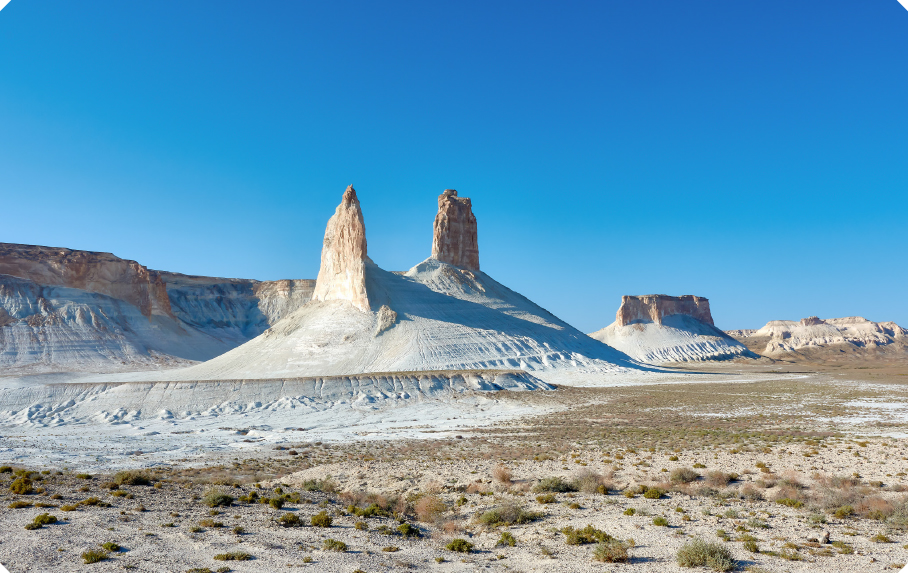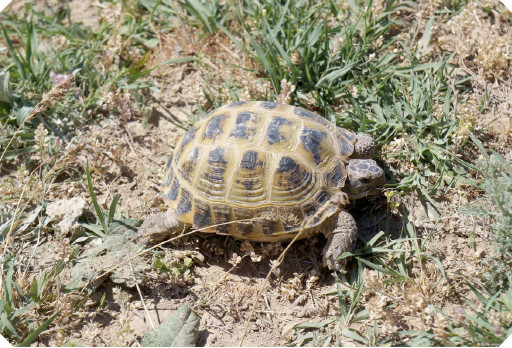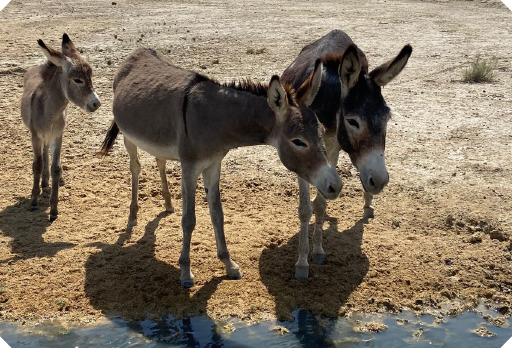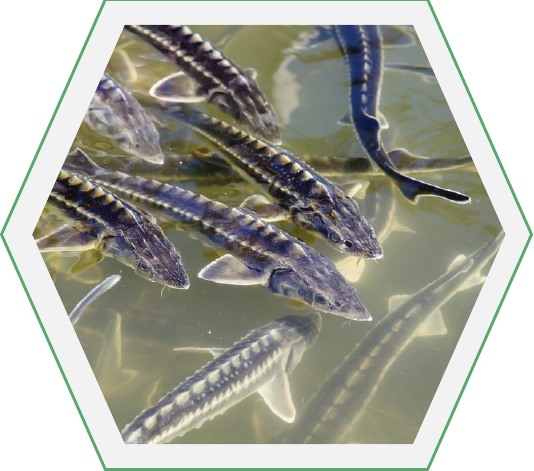Biodiversity Conservation and Support of Specially Protected Natural Areas
Protected Natural Areas within Our Footprint and Affected Species of Flora and Fauna
North Caspian is the most productive part of the Caspian Sea. This part of the sea is rich with biological resources. The main commercial fish fauna includes 25 species, of which the most valued are sturgeons with 70-80 % of their global reserve living in the basin.
Eastern water area of the North Caspian with deltas of Volga (within the RoK) and Ural is a part of the State Conservation Area in the North Caspian Sea. Wetlands of the North Caspian, particularly deltas of Volga, Ural and Emba, and the adjacent coast and the sea area itself are essential for Eurasia and support millions of water birds and semiaquatic birds during nesting, moulting, seasonal migrations and wintering. One of the largest Eurasian flyways, the Siberia – Black Sea – Mediterranean Sea flyway, crosses the North Caspian.
According to the baseline studies, more than 70 bird species (including 5 rare species from the Red Book of Kazakhstan) migrate through open areas of the North-East Caspian 20-60 km away from the shore.
Little egret, spoonbills, pelicans, whooper swan, ferruginous duck and great black-headed gull are nesting near the shore. Swamphen, white-tailed eagle and osprey are also observed flying.
Land cenoses are nesting grounds for 5 species of birds from the RoK Red Book. Steppe eagle is the most common one. As for rare birds, avocets, oystercatcher, little egret may be observed in these areas.
The only large marine mammal (pinniped) of the Caspian Sea is Caspian seal (Phoca caspica). It is an endemic mammal species. Seals are spread throughout the Caspian Sea, although they vary in number in the North part depending on season. Seasonal distribution of animals across the sea area is based on three main phases of the annual cycle: reproduction, moulting and feeding. Reproduction grounds are in the North Caspian that freezes in winter. During feeding period from April to September, seals mainly stay in the Middle and South Caspian. In summer, only a few animals (about 30,000) remain in the North Caspian, the majority of population moves to the deeper and colder South Caspian waters. They migrate to the North shallow waters in the late autumn, where water starts to freeze. The majority of population gathers in the North Caspian in October – November.
This area is essential to conserve biodiversity of Kazakhstan and the entire Eurasian continent and it needs to be continuously monitored and timely protected. From the very beginning of its operations in the North Caspian, KMG has focused on protection of environment of the region.
“Isatai” area is in the northern part of the Caspian Sea, 45 km north of the coast of Bozashy Peninsula, in Mangystau Region.
“Abai” area is located in the north-western part of the Kazakhstani Sector of the Caspian Sea in the area of a water body of the Caspian Sea 60-70 km north of the coast of Buzachi peninsula and geographically belongs to Atyrau Region. The area is located in the preserved area of the Caspian Sea.
“Al-Farabi” area is located in the southern part of the Kazakhstani Sector of the Caspian Sea and geographically belongs to Mangystau region of the RoK. The western border of the Al-Farabi site is adjacent to the state border between the Republic of Kazakhstan and the Russian Federation in the area of a water body of the Middle Caspian Sea.
Mangystau Region. Mangystau Region has a vast system of speically protected natural areas including Ustyurt State Nature Reserve and Kenderli-Kayasan Conservation Area of republican status, as well as 8 reserves and 1 natural park of regional subordination. Blotched snake (Elaphe sauromates) is a reptile listed in the Red Book of the Republic of Kazakhstan (2010) and inhabiting Mangystau Region. Afghan tortoise is a common, well spread species that is quite numerous in certain areas of Mangystau Region, nevertheless, according to criteria of the Red List of International Union for Conservation of Nature (IUCN) it is a vulnerable species.
Kenderli-Kayasan Conservation Area of republican status was established to preserve habitat and natural reproduction grounds of houbara bustard and saker falcon. Established status: conservation area, reserve, controlled status.
Karazhambas field is in the north-western part of Buzachi Peninsula, within Caspian Depression, in the territory bordering the Caspian Sea on the west. In the west, the field borders the State Nature Conservation Area of the North Caspian Sea. Industrial environmental monitoring includes biannual flora and fauna monitoring.

Aktobe region. Kokzhide-Kumzhargan State Integrated Nature Reserve of local status. This reserve accommodates two sites of nature reserve fund of republican status: Kokzhide Sands and Kokzhide Groundwater, which are included in the List of Geological Sites of the State Nature Reserve Fund of republican and international status.
Urikhtau, Alibekmola and Kozhasai fields are located in Mugalzhar District of Aktobe Region of the RoK. Northwestern part of the contract territory of Urikhtau field lays on the Kokzhide Sands, the fields also border the Kozhide−Kumzhargan State Integrated Nature Reserve of local status. To avoid groundwater pollution, environment is being regularly monitored both within the Group operations footprint and near the Kokzhide Sands adjoining the contract territory. Consultations are also underway with the authorized bodies in the field of environmental protection and subsoil use to develop the necessary actions for the management of this subsurface area and further safe work.
Production sites located within and near the specially protected natural areas
|
Type of SPNA |
Within borders |
Adjacent borders (includes a part of territory) |
Outside borders (located within 1-10 km) |
|---|---|---|---|
|
Category IUCN I-IV |
– |
– |
– |
|
Category IUCN V-VI |
Isatai Abai Kalamkas-Khazar |
Urikhtau |
Alibekmola Kozhasai Karazhanbas Rozhkovskoye |
|
World heritage sites |
– |
– |
– |
|
Ramsar lands |
– |
– |
– |
Our Contribution to Biodiversity Conservation in 2023
As part of the Environmental Policy, we are committed to:
- not operate in specially protected natural areas of special value as habitats for rare, endangered and valuable animal species, carry out risk assessments when operating in environmentally sensitive areas;
- applying a hierarchy of biodiversity impact mitigation actions when planning and implementing its operations based on four key actions: prevention, minimisation, restoration and compensation of potential significant direct impacts;
- participating in research programmes and industry partnerships to further accumulate knowledge and develop innovative solutions for environmental and biodiversity protection;
- preventing illegal hunting, fishing and other use of flora and fauna by own employees and the employees of contractors and subcontractors in contract areas.


Baseline environmental studies, well drilling and testing took place on the sites within the North Caspian state nature conservation area. There are currently no significant mancaused effects in these regions, which would restrict free movement of wild animals and birds within their habitats. During drilling operations, the following activities have environmental impacts: drilling rig installation, well drilling and testing, navigation. The impact factors are increased concentrations of suspended solids in water during offshore construction, disturbance of natural structure of bottom deposits due to intensive navigation among other things, physical effects of noise.
Industrial environmental monitoring of the environment, abandoned wells and research and development (R&D) in the areas of hydrology, hydrochemistry, hydrobiology and ichthyology are within to compensate for unavoidable damage to fish resources caused by operations.

In July 2023 under the contract with Aktau-Balyk LTD LLP, Zhenis Operating LLP carried out works on compensation of damage to fish resources during construction and liquidation of well V-1 by releasing fish seed (sterlet) in the quantity of 4,467 pcs into the Ural River (Atyrau Region, RoK). This work was carried out in order to compensate for unavoidable damage to fish resources and replenish the biodiversity of the Caspian Sea. The amount of compensation for damage to fish resources in monetary terms amounted to KZT 5.9 mln.
One of the negative impacts of industrial activities, which also have an impact on biodiversity, is power lines, which pose a serious threat to avifauna. The death of birds as a result of collisions with wires and electrocution is becoming one of the most acute problems of wildlife protection, especially in steppe and semi-desert areas of the country, where the absence of woody vegetation makes overhead power transmission towers the most attractive for nesting and resting places for many species of birds of prey.
Identification and investigation of areas of increased danger of electrical installations for birds are carried out in the course of special surveys or as part of industrial environmental control.
|
|
Onshore Operations |
Offshore Operations |
||||
|
2021 |
2022 |
2023 |
2021 |
2022 |
2023 |
|
|
Areas for which biodiversity is covered by an EIA or similar document (%) |
100 |
100 |
100 |
100 |
100 |
100 |
|
Areas subject to regular environmental monitoring (%) |
100 |
100 |
100 |
100 |
100 |
100 |
|
Areas with abandoned wells subject to regular environmental monitoring (%) |
100 |
100 |
100 |
100 |
100 |
100 |

To exclude bird deaths from electric shock on overhead power lines at the main pipeline facilities of KazTransOil JSC, works on installation of bird protection devices (BPD) at Pavlodar Oil Pipeline Department for the amount of KZT 15,045 thousand, at Karaganda Oil Pipeline Department – for the amount of KZT 15,300 thousand were carried out in 2023.
In March 2023, KMG experts participated in the workshop meeting to develop a sensitivity map for oil spill response purposes in the Kazakhstan sector of the Caspian Sea, organised by the Oil Spill Preparedness Regional Initiative. Current methods of monitoring of offshore areas using new technologies were presented, the need to create a sensitivity map in the Kazakhstan sector of the Caspian Sea was pronounced in order to ensure preparedness and response to oil pollution and to organise cooperation.
In September 2023, KMG experts took part in the Workshop “Birds of Prey and Energy“ as part of the III International Scientific and Practical Conference “Palearctic Eagles: Study and Protection“ organised by Biodiversity Research and Conservation Centre Public Foundation(BRCC). Such relevant topics as the development of practical actions to mitigate negative factors affecting raptors in steppe and desert regions, such as bird mortality at power grid facilities, RES, improvement of legislation in the field of avifauna, international experience in bird rescue, types of bird protection devices for overhead lines and substations were presented and discussed.
The negative impact of KMG Group’s operations on biodiversity is mitigated both within and outside the boundaries of protected areas. The biodiversity conservation policy provides for the preservation of habitats and migration routes of animals, minimisation and compensation of possible environmental damage, and reduction of disturbed areas. Actions to minimise negative impacts include reduction of the duration, intensity, as well as direct and indirect levels of impact of operations at oil production and transportation facilities.
The Company is open for consideration of any initiatives, ideas and actions for biodiversity conservation and requests that they be sent to: hse@kmg.kz.
- ECOLOGY AND INDUSTRIAL SAFETY
- Our Management Approach
- Water Management Programme
- Environmental Protection
- Air Protection
- Sustainable Use of Crude Gas
- Waste Management and Land Reclamation
- Decommissioning and Reclamation of Work Sites
- Offshore Well Control
- Oil Spill Prevention and Response
- Biodiversity Conservation and Support of Specially Protected Natural Areas
- Environmental Management Training of Personnel
- Environmental Assessment of Planned Economic Activities
- Public Organisation Engagement
- Green Office Concept in KMG
- Occupational Health and Safety
- Contractor Engagement
- Occupational health, safety, and hygiene
